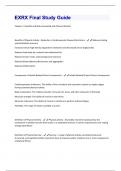EXRX Final Study Guide
Chapter 1: Benefits and Risks Associated with Physical Activity
Benefits of Physical Activity - Reduction in Cardiovascular Disease Risk Factors - Reduced resting
systolic/diastolic pressure
Increased serum high-density lipoprotein cholesterol and decreased serum triglycerides
Reduced total body fat, reduced intra-abdominal fat
Reduced insulin needs, improved glucose tolerance
Reduced blood platelet adhesiveness and aggregation
Reduced inflammation
Components of Health-Related Fitness Components - Health-Related Physical Fitness Components
Cardiorespiratory endurance: The ability of the circulatory and respiratory system to supply oxygen
during sustained physical activity.
Body composition: The relative amounts of muscle, fat, bone, and other vital parts of the body.
Muscular strength: The ability of muscle to exert force.
Muscular endurance: The ability of muscle to continue to perform without fatigue.
Flexibility: The range of motion available at a joint.
Definition of Physical Activity - Physical activity - Any bodily movement produced by the
contraction of skeletal muscles that results in a substantial increase in caloric requirements over resting
energy expenditure
Definition of Physical Exercise - Exercise - A type of physical activity consisting of planned,
structured, and repetitive bodily movement done to improve and/or maintain one or more components
of physical fitness
,Components of Skill-Related Fitness Components - Skill-Related Physical Fitness Components
Agility: The ability to change the position of the body in space with speed and accuracy.
Coordination: The ability to use the senses, such as sight and hearing, together with body parts in
performing tasks smoothly and accurately.
Balance: The maintenance of equilibrium while stationary or moving.
Power: The ability or rate at which one can perform work.
Reaction time: The time elapsed between stimulation and the beginning of the reaction to it.
Speed: The ability to perform a movement within a short period of time.
Definition of METs Ranges for low, moderate, and high intensity - 1 MET = energy cost of rest
(1MET = 3,500ml/kg/min)
Light: <3 METs
Moderate: 3-6 METs;
Walking 3mph/Water Aerobics/Biking <10mph, Ballroom Dance/Gardening
Vigorous: >6 METs
Jogging or running, Lap swimming, Bicycling (>10 mph), Aerobic dancing, Heavy gardening (digging),
Backpacking
Physical Activity relationship with different disease states (HINT: Inverse Relationship) - 150
min/week of PA = ↓ CHD risk by 14%
300 min/week of PA = ↓ CHD risk by 20%
Benefits of Physical Activity - Improvement in Cardiovascular and Respiratory Function - Increased
maximal oxygen uptake resulting from both central and peripheral adaptations
Decreased minute ventilation at a given absolute submaximal intensity
Decreased myocardial oxygen cost for a given absolute submaximal intensity
,Decreased heart rate and blood pressure at a given submaximal intensity
Increased capillary density in skeletal muscle
Increased exercise threshold for the accumulation of lactate in the blood
Increased exercise threshold for the onset of disease signs or symptoms (e.g., angina pectoris, ischemic
ST-segment depression, claudication)
Benefits of Physical Activity - Decreased Morbidity and Mortality - Primary prevention (i.e.,
interventions to prevent the initial occurrence)
Higher activity and/or fitness levels are associated with lower death rates from coronary artery disease
Higher activity and/or fitness levels are associated with lower incidence rates for CVD, CAD, stroke, Type
2 diabetes mellitus, metabolic syndrome, osteoporotic fractures, cancer of the colon and breast, and
gallbladder disease
Secondary prevention (i.e., interventions after a cardiac event to prevent another)
Based on meta-analyses (i.e., pooled data across studies), cardiovascular and all-cause mortality are
reduced in patients with post-myocardial infarction (MI) who participate in cardiac rehabilitation exercise
training, especially as a component of multifactorial risk factor reduction
Randomized controlled trials of cardiac rehabilitation exercise training involving patients with post-MI do
not support a reduction in the rate of nonfatal reinfarction (MI).
Benefits of Physical Activity - Other Benefits - Decreased anxiety and depression
Improved cognitive function
Enhanced physical function and independent living in older individuals
Enhanced feelings of well-being
Enhanced performance of work, recreational, and sport activities
Reduced risk of falls and injuries from falls in older individuals
Prevention or mitigation of functional limitations in older adults
Effective therapy for many chronic diseases in older adults
, Benefits of Physical Activity - Recommendations - 30 min of moderate intensity exercise 5 days per
week or 20 min of vigorous intensity exercise 3 days per week
Risks associated with exercise - Exercise Related Cardiac Events
Exercise Testing and The Risk of Cardiac Events
Prevention methods (cardiac events)
Health care professionals should know the pathologic conditions associated with exercise-related events
so that physically active children and adults can be appropriately evaluated.
Physically active individuals should know the nature of early cardiac symptoms and seek prompt medical
care if such symptoms develop
High school and college athletes should undergo preparticipation screening by qualified professionals.
Athletes with known cardiac conditions or a family history should be evaluated prior to competition
using established guidelines.
Chapter 2: Preparticipation Health Screening - -
Pre-participation screening procedures - Including self- guided methods --PAR-Q (7 Questions),
AHA/ASCM Health/Fitness Facility Pre-participation Screening Questionnaire (2 or less low risk, more
than 2 moderate, others high risk)
CVD risk factor assessment and classification by qualified health/fitness, clinical exercise, or health care
professionals.
Medical evaluation including a physical examination and stress test by a qualified health care provider
Risk Classification Level - Low <2 risk factors - asymptomatic
Moderate >2 risk factors - asymptomatic
High (Known cardiovascular, pulmonary, renal, or metabolic disease)
Major Signs or Symptoms for Cardiovascular, Pulmonary or Metabolic Disease - Pain, discomfort in
the chest, neck, jaw, or area from Ischemia




